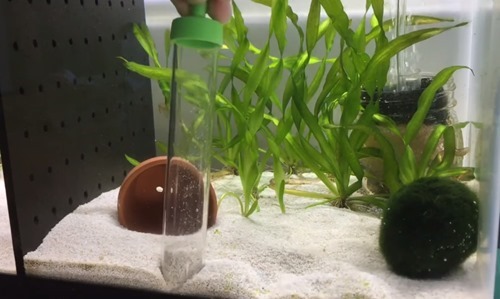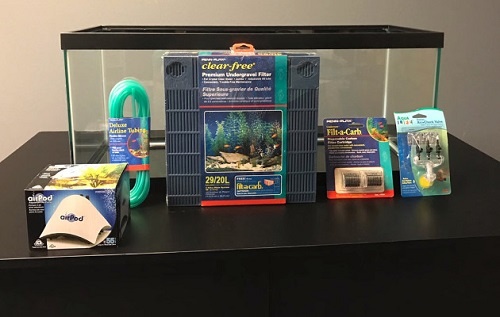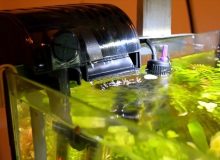Undergravel filter: how it works, the bestsellers, and installation
An undergravel filter is one of the most efficient fish tank accessories that act as a biological filter. While you can easily purchase this accessory online, you should first understand the concept and science behind this product and how to properly set it up to attain the best results.
- How does an undergravel filter work?
- How to install an undergravel filter?
- Best undergravel filter review
- Do You Need an Undergravel Filter?
- Frequently Asked Questions
How does an undergravel filter work?
When fish eat, they defecate afterward. Along with other unwanted particles, fish feces will sink to the bottom. If left untreated or not retrieved, it will decompose releasing toxic substances like ammonia and nitrites. Designed with a slatted base (or a slit) and covered with gravel (pebbles or small rocks but NOT SAND since it will pass through), undergravel filters act as a sieve allowing unwanted particles to settle at the bottom.
But here’s the thing: an undergravel filter can not work alone and it needs further accessories to be fully functional. In this case, undergravel filters need either an air pump or a powerhead pump, both of which do not come with the product and are sold separately.
In the case of air pumps, the air is pumped through a line from the bottom of the tank. In effect, bubbles will rise to the surface pushing water downwards towards the gravel.
For powerhead pumps, water (along with the unwanted substances) is vacuumed at the bottom, filtered, and released out clean water at the surface through the filter tubes.
Here’s an illustration showing the difference between an undergravel filter powered by an air pump (left) and a powerhead pump (right).

Photo courtesy from Wikipedia Commons
Regardless of an air pump or a powerhead pump that you will use together with the undergravel filter, these pump accessories create water movement that facilitates the filtration of unwanted substances. As water is circulated in the tank as an effect of the use of undergravel filter and pump, filtration will occur in many forms:
Mechanical filtration
The gravel that covers the undergravel filter is not just for aesthetic purposes. It acts as a mechanical filter by trapping large particles as the water is being circulated. As particles accumulate, you need to mechanically remove them during water change or with the use of an aquarium gravel cleaner.

Cleaning the substrate with a gravel vacuum cleaner.
Biological Filtration
This type of filtration occurs primarily in the gravel itself, at the bottom of the tank as created by the false floor of the undergravel filter, and in the walls of the filter tubes. Since the said areas provide surface, it promotes the growth of bacteria which breaks down the unwanted substances (primarily ammonia and nitrites) making your tank water safe for the fish to thrive.
Chemical Filtration
Using activated substances like carbon, these substances absorb chemicals released from fish food, fish feces, and the breaking down and decomposition of unwanted substances.
You have to take note that not all undergravel filters have a chemical filtration system. In the absence of a chemical filtration system that goes with your undergravel filter, you can use canister filters that have been proven to be effective in taking out unwanted substances, in this case, chemicals.
How to install an undergravel filter?

Setting up an undergravel filter is very easy. However, you need to follow these steps to attain maximum filtration efficiency:
- Since it is located at the bottom-most part of the tank, an undergravel filter should be the first accessory that you should install. Nothing should go first except for the parts and components of the undergravel filter.
- Depending on the size of your tank, place one or more plates and lay them flat at the bottom of the tank.
- Connect the filter tubes (usually in a vertical position) to the plates. These tubes will act as a vacuum that will siphon the unwanted substances.
- Once the plates and the tubes are laid out, place gravel on top of it that will act both as a substrate and a mechanical filter. Please take note to place just the right amount of gravel creating an optimum layer (not too thin and not too thick). Based on practice, the recommended gravel layer is 1.5 to 3 inches thick.
- Pour in water, initially just above the gravel layer. At this moment, make some adjustments and make sure that water freely flows underneath the substrate. If you place too much gravel, water movement towards the undergravel filter is restricted. Likewise, the undergravel filter will not hold in place if you place too little gravel and may float.
- After checking, pour in water up to the suggested water level in your tank and allow it to settle for a few seconds.
- After settling, turn on the pump and check if there is water movement. In the case of air pumps, water should be bubbling out of the filter tubes. On the other hand, clean and filtered water is released back if you use powerhead pumps.
- Adjust the pump rate in such a way that it mimics the natural environment of the fish that you will keep in the aquarium.
Best undergravel filter review
Penn Plax CFU Series Undergravel Filter

 Check on Amazon #ad
Check on Amazon #ad
- Tank Size Compatibility: 5-55 gallons (multi sizes for choice)
- Habitat Compatibility: Freshwater and Saltwater
- Powered by: Air pump or Powerhead pump
With different tank size compatibility, the Penn Plax CFU series is one of the most versatile undergravel filters in the market. It has multi-size choices that are compatible ranging from a 5-gallon tank up to the large 55-gallon aquarium.
Here are the specifications and inclusions for each of the Penn Plax CFU Series undergravel filters:
| Model # | CFU5 | CFU10 | CFU20 | CFU29 | CFU55 |
| Compatible Aquarium Size | 5 gallon | 10 gallon | 15 – 20 gallon | 20 – 29 gallon | 40 – 55 gallon |
| Dimension when Installed | 15.5″ x 7.5″ | 19″ x 9.5″ | 23″ x 11.5″ | 28.5 x 11.5″ | 46″ x 11.5″ |
| Individual Plate Size | 7.5″ x 7.5″ | 9.5″ x 9.5″ | 11.5″ x 11.5″ | 14.25″ x 11.5″ | 11.5″ x 11.5″ |
| No. of Plates Included | 2 | 2 | 2 | 2 | 4 |
Aside from versatility, the Penn Plax CFU series is a highly efficient undergravel filter where it is compared and associated with high-tech filters, but with hassle-free maintenance. It comes with filter plates, air stones, and adjustable lift tubes.
On top of this, it has carbon filter cartridges that are installed in the return hose. If you decide to replace the filter cartridge, you can easily purchase its Activated Carbon Replacement Cartridge #ad or you can accompany it with the Ammonia-X Zeolite Media Cartridge #ad which is top-rated for ammonia absorption.
All in all, the Penn Plax CFU Series undergravel filter provides a powerful biological and chemical filtration system as manifested in your tank’s crystal clear waters.
You can assemble this undergravel filter system in less than 5 minutes. After removing the product packaging, start by attaching the plates, assemble the lift tubes, and secure them in the plates. Once assembled, place the entire filter system at the bottom of the tank, connect the lift tube to an air pump or a powerhead filter, add gravel on top of the plate, and finally, add water.

 Check on Amazon #ad
Check on Amazon #ad
- Tank Size Compatibility: 5-100+ gallons (many sizes for choice)
- Habitat Compatibility: Freshwater and highly recommended for Saltwater
- Powered by: Air pump or Powerhead Pump
If you are looking for a base plate that does not need any further assembly, then you may consider Lee’s Premium Undergravel Filter. Varying in length and width to fit a variety of tank sizes, the base plate of this undergravel filter is one solid piece and all you need to assemble is the filter tube attachment.
Here are the specifications for the different models of Lee’s Premium Undergravel Filters:
| Model # | Plate size | For tanks |
| Lee's 5-1/2 #ad | 14.75″ x 7.25″ (x 1 plate) | 5.5 gallon (16 by 8 inch) |
| Lee's 10 #ad | 19″ x 9.25″ (x 1 plate) | 10 gallon (20 by 10 inch) |
| Lee's 15/20 #ad | 22.63″ x 11.25″ (x 1 plate) | 15-20 gallon (24 by 12 inch) |
| Lee's 20L/29 #ad | 28.63″ x 11″ (x 1 plate) | 20 gal long / 29 gal (30-inch long) |
| Lee's 30 #ad | 34.25″ x 11.13″ (x 1 plate) | 30 gallon (36 by 12 inch) |
| Lee's 40/55 #ad | 22.25″ x 11.38″ (x 2 plates) | 40 – 55 gallon (48 by 12 inch) |
| Lee's 50/65 #ad | 17.63″ x 16.5″ (x 2 plates) | 50 – 65 gallon (36 by 18 inch) |
| Lee's 70/90 #ad | 22.88″ x 16.25″ (x 2 plates) | 70 – 90 gallon (48 by 18 inch) |
| Lee's 125/135 #ad | 23″ x 16.25″ (x 3 plates) | 125 – 135 gallon (72 by 18 inch) |
And it’s not just about its 1-piece characteristic, the base plate has added characteristics making it one of the highly preferred undergravel filters. First, the base plate has a sloping angular orientation. In effect, unwanted substances will naturally go to the false bottom as water is circulated, making it an efficient mechanical filter. And second, the base plate is made from a special quality plastic that can resist splitting or cracking, making it highly preferred by saltwater aquarists. This product also comes with a filter tube with active charcoal for chemical filtration.
Imagitarium Undergravel Filter

 Check on Amazon #ad
Check on Amazon #ad
- Tank Size Compatibility: 10 gallon
- Habitat Compatibility: Freshwater and Saltwater
- Powered by: Air pump and Powerhead pump
This undergravel filter is similar to the Penn Plax CFU series undergravel filter, except that this unit is specifically designed for a 10-gallon tank. It has a 2 slatted plastic base that can be easily assembled and locked together. It also comes with 2 filter tubes, each equipped with a filter cartridge that is embedded with activated carbon for chemical filtration. In case you want to change the filter cartridge, this unit is compatible with the Penn Plax carbon replacement filters or the Penn Plax Ammonia X replacement filter.
Undergravel Filtration Bottom Circular Bar

 Check on Amazon #ad
Check on Amazon #ad
- Tank Size Compatibility: 55 gallon
- Habitat Compatibility: Freshwater and Saltwater
- Powered by: Powerhead pump
Instead of using base plates and powered by a powerhead pump, this undergravel filter uses circular plastic bars with multiple slits. In effect, the suction of unwanted materials occurs anywhere at the bottom, thereby increasing its filtration efficiency.
This product is composed of slitted tube pipes, circular bar tubes, and connector joints. This means that this undergravel filter can be customized where you can install and connect the pipes depending on the length, width, and shape of your tank.
Do You Need an Undergravel Filter?
If you are not sure whether you need an undergravel filter or not, then you may answer this question by considering several factors, like:
Factor 1: Frequency of water change. How often do you need to change the water? Does your water tank easily get fouled? Do you have time for a frequent water change?
Factor 2: The type of fish you are keeping. Are your fish voracious and messy eaters? How often does your fish defecate?
Factor 3: Stocking density. Are you keeping a small amount of fish or do you want to maximize your tank space and add more fish?
With these factors in place, you should use an undergravel filter when:
- You have no time for a frequent water change. Remember that the undergravel filter will do the work for you. This is except for too much fouling, defecation or an accidental feed dislodge where you need to do the water exchange yourself. This idea will also complement if you are planning to keep a low-maintenance aquarium.
- You have a high stocking density. Sometimes, we are overwhelmed by the beauty and behavior of the fish that we tend to add more fish to the tank. If this is the case, then expect more feeding and defecation which means that you need an added filter system.
- You are using chemically-induced fish feeds. Some feeds are fortified with vitamins and minerals in the form of chemicals. If these chemicals are not consumed, they can add to your water’s chemical content and this is where the chemical filtration characteristics of undergravel filters come into use.
- You are keeping fish that are messy eaters and defecates frequently. Although not all fish species, there are certain fish that are messy eaters and frequently defecate, like a plecostomus. So, you need to use an undergravel filter to address this kind of fish behavior.
- You simply just want to place an added form of filter in your tank. There’s no harm if you spend a few bucks for an undergravel filter in exchange for the added filtration work.
Frequently Asked Questions
Are undergravel filters good for live plants?
It depends on the root system of the live plants that you are keeping. Undergravel filters are ideal for plants that have a small root system. However, if you are keeping live plants that have a massive root system, the use of an undergravel filter is not ideal as the roots can block and restrict water flow, thereby decreasing the filter efficiency.
Do undergravel filters trap baby fish or shrimp?
Baby fish and shrimps usually stay on top of the gravel and can easily handle mild water flow. In fact, baby fish and shrimps need a mild flow of water for growth and development. However, it is a different story if your tank has a strong water flow where baby fish and shrimp could be carried away and trap either in the false bottom of the undergravel filter or in the filter tubes.
Should I use an undergravel filter?
As we mentioned earlier, some factors need to be considered for you to come up with a decision. Factors like frequency of water change, the type of fish that you are keeping, and the stocking density. You should use an undergravel filter when you have no time for a frequent water change, you have a high stocking density, you are using chemically-induced feeds, you are keeping fish that are messy eaters and defecates frequently.
How do I maintain and clean an undergravel filter?
When the time comes that you need to clean your undergravel filter, you really don’t need to take it out completely of the tank. All you need is a vacuum cleaner. Using the power of suction and by pointing the vacuum tube to the target area, you can easily remove the accumulated dirt, feces, and other unwanted materials.
Can I use the undergravel filter and power filter together?
Yes. In fact, power filters are one of the options that can power up an undergravel filter and function it to its full potential. The other option you have in powering up an undergravel filter is an air pump.
Can I use an undergravel filter with sand substrate?
No. We have to remember that the base plates of the undergravel filter are either slatted or has slits (in the case of a circular bar). When you use sand, instead of covering the top surface of the undergravel filter that will act as a substrate and a mechanical filter, the sand will just drop on the false bottom. In effect, it will significantly block the flow of water and reduce filter efficiency.
What is a reverse-flow undergravel filter?
A typical undergravel filter pulls out water from the gravel, passing through the false bottom and in the filter tube before it is released back as clean and filtered water. In the case of a reverse-flow undergravel filter, it is the other around: water is being pushed out of the gravel from the false bottom. That’s the reason why you see some bubbles coming out of the gravel if you use a reverse-flow undergravel filter.
How do I choose an undergravel filter for a hexagon tank?
Hexagon tanks are unique since it has 8 sides as compared to the traditional 4-sided tank we all know. You still can install an undergravel filter in a hexagon tank, provided that you choose a base plate that has a square shape. In this instance, what we can recommend for a hexagon tank is the Penn Plax undergravel filter. And by the way, choose a base plate that has a similar length (should not exceed) to your hexagonal tank so you can easily install it and lay it flat at the bottom.
Enjoy and happy fish keeping!


Leave a Reply